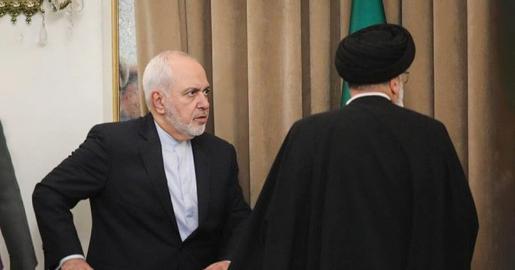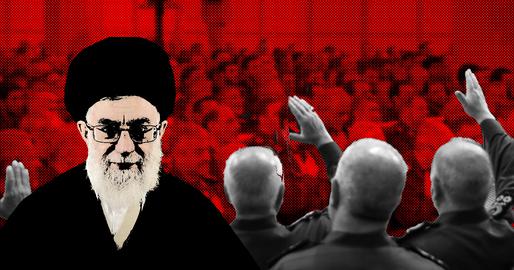If nuclear negotiations between Iran and the leading Western powers remain inconclusive, that is likely due in part to what such a deal would symbolize politically: a new relationship between Iran and the only truly major power in the negotiating group, the United States. Ever since Ayatollah Khomeini’s supporters smashed diplomatic relations by besieging the US Embassy in Tehran in 1979 and holding embassy staff hostage, US leaders have been at a loss to repair them. Iranian leaders, meanwhile, have long been able to draw on reservoirs of mistrust based on the CIA’s involvement in the 1953 coup that overthrew Iran’s nationalist Prime Minister Mohammad Mossadeq and installed Mohammad Reza Pahlavi as a dictator. Yet even as both parties have nursed their wounds and dealt each other new ones over the past three and a half decades, the possibility of rapprochement has always excited hopes and fears on both sides.
1. Iranian hardliners liken America to Shemr, the villain of Shiism.
The Islamic Republic has long denounced America as “the Great Satan,” but in recent years, billboard campaigns inside Iran have drawn a more high-context analogy with Shemr, an infamous enemy of Shia Islam. In 680, Shemr was the general of the caliph Yazid, whose army slew Hussein, Shiism’s Second Imam, at the Battle of Karbala. “Shemr has come to symbolize all things tyrannical,” says Ahab Bdaiwi, lecturer in Middle Eastern History at the University of St. Andrews. “Throughout history, it has been very common for Shia thinkers to read present-day situations by relating them to the tragic history of Shia Islam.” Last year, large billboards in Tehran depicted Shemr next to US President Barack Obama. New billboards displayed this month show the US Capitol building in Shemr’s camp — a likely reference to Congress’s desire to sustain sanctions pressure on Iran.
2. Iran owned a huge New York skyscraper — until the US seized it.
In the late 1970s the Shah’s nonprofit Pahlavi Foundation built a 36-story, 382 500 square-foot skyscraper at 650 Fifth Avenue in Manhattan. Following the 1979 revolution, the Islamic Republic took control of as many of the Shah’s assets as it could, including the Pahlavi Foundation, and the building ended up in the hands of two Iranian partners, the Assa Corporation and The Alavi Foundation. In 2009, the Manhattan US Attorney’s office argued in a lawsuit that the Iranian government controlled the Alavi foundation, and that Assa was a front for Iran’s state-run Bank Melli. In 2013, a judge found that the building’s owners were shielding Iranian assets, and that victims of Iranian terrorism who had won court judgments against Iran could receive compensation through the building’s sale. She called it "the largest-ever terrorism-related forfeiture" in US history.
3. Qods force commander Ghassem Suleimani sent US General David Petraeus an unexpected text message.
In 2007, Iran escalated its campaign against US forces in Iraq by providing high-powered improvised explosive devices (IEDs) and other sophisticated equipment to Shia militias. “Part of that was to deliberately influence the Shia community in ways that the Iranians wanted,” says US Government historian David Crist, “but also it was an effort to erode American strength and resolve in Iraq so the US would pull out.” In 2008, Ghassem Suleimani, head of the Qods Force, a special forces unit of the Iranian Revolutionary Guards, sent US General David Petraeus, then head of US Central Command, a surprise text message. “It basically said, ‘Don’t forget, I’m the guy who controls what goes on in Iraq,”’ Crist says. “Petraeus sort of dismissed it.”
4. Hassan Rouhani believes in 9/11 conspiracy theories.
In 2001, many Iranians publicly mourned the September 11 terrorist attacks against the United States. Hassan Rouhani, then head of Iran’s Supreme National Security Council, also condemned the attacks. But in a Friday prayers sermon later that month, he advanced a theory popular among American 9/11 conspiracy “truthers” when he claimed that United Airlines flight 93, which crashed in a field in Pennsylvania, had been brought down by a US missile. (In fact, it had crashed after passengers overpowered the hijackers). Rouhani, a professional censor, also faulted US media for not reporting the views of European “analysts” who said “Zionists” had carried out the attacks. “This shows that freedom of the press, radio, and TV and the free flow of information are illusions,” he said.
5. A high-ranking US official acknowledged America’s role in the 1953 coup against Mohammad Mossadeq.
In a 2000 speech to the American Iranian Council, US Secretary of State Madeleine Albright embraced reformist Iranian President Mohammad Khatami’s call to bring down the “wall of mistrust” between the US and Iran. Famously, she acknowledged that the US had played a “significant role” in the overthrow of Iranian Prime Minister Mohammad Mossadeq in 1953, a move she said had set back Iran's political development. “Albright’s speech,” says Malcolm Byrne of the National Security Archive in Washington, D.C., “is certainly the highest profile, most-remembered reference to those events. Unfortunately, it didn’t go very far because it was pointed out that this was not really an apology, as some claimed.” Iranian Supreme Leader Ali Khamenei objected to Albright’s reference in the speech to “unelected hands” controlling Iranian institutions.
6. George H. W. Bush took a phone call from a Rafsanjani imposter.
US President George Bush came to office with the aim of securing the release of American hostages held by Iran-backed Hezbollah militants in Lebanon. He reached out to Iran in his inaugural address in 1989, remarking that Iranian assistance would be remembered because “goodwill begets goodwill.” In 1990, a caller claiming to represent Iranian President Rafsanjani called the National Security Council and made an appointment to speak to Bush. After Bush took the call, he and his staff determined that it had been a hoax. The real Rafsanjani gloated over the incident, remarking, “Can it be that such a global power, with all its intelligence capabilities, talks to a person it cannot identify? This shows the United States very much needs to talk to Iran, but, with God's grace, it is deprived of this blessing.”
7. The US accidentally shot down an Iranian airliner—and refused to apologize.
In 1988, toward the end of the Iran-Iraq War, both sides attacked neutral ships in the Persian Gulf. The United States sent navel forces, including the USS Vincennes, to the region to protect shipping. After pursuing a skirmish with Iranian boats in Iranian waters, says US Government historian David Crist, the Vincennes crew, through a series of human errors, mistook an overflying Iran Air plane for an attacking F-14 fighter jet. The captain, William Rogers, ordered it to be shot down. The Vincennes had killed 290 people. After the incident, Crist says, the US government was “pretty liberal with the truth,” and tried to shift the blame to Iran. In 1990, the US Navy awarded Rogers a Legion of Merit medal. “The Iranians looked at that and said, ‘That’s proof that this was a deliberate act of murder by the United States,’” Crist says. The US paid reparations in 1994, but has never apologized.
8. The US knew Saddam Hussein had used chemical weapons against Iranians—but shared intelligence with him anyway.
While the administration of US President Ronald Reagan disliked Saddam Hussein’s Baathist regime in Iraq, Reagan was determined to prevent Iran from winning the Iran-Iraq War. In 1988, according to a Foreign Policy article based on declassified CIA documents and published last year, the US concluded, using satellite data, that Iran was poised for a major victory. They passed Iraq military intelligence in full knowledge that its forces would use sarin gas against Iranian troops. The documents show that the US had clear evidence of Iraqi chemical weapons attacks dating to 1983, which it kept under wraps — even as Iran sought evidence to present against Iraq at the UN. “The Reagan administration decided that it was better to let the attacks continue if they might turn the tide of the war,” the article says.
9. The former US Embassy in Tehran is a museum—but good luck getting in.
On November 4 1979, supporters of Ayatollah Ruhollah Khomeini besieged the US Embassy in Tehran and held its staff hostage for 444 days. The former embassy building on Taleghani Avenue occupies a full city block, and anti-American murals still cover its surrounding walls. The chancery building inside is a museum devoted to the so-called “den of spies,” but it’s not exactly public. Mark Bowden, author of Guests of the Ayatollah, talked his way in — with some difficulty — in 2004. “It wasn’t a ‘Sure, come on in’ kind of deal,” Bowden says, “but it was set up for people to come in and see. They bring busloads of high school students through.” The Revolutionary Guards, he says, appeared to be using the grounds as a base, but many of the interiors remain much as American staff left them in 1979. “As long the Revolutionary Guards want it, they’re going to probably keep it. I doubt the United States will be back there any time soon.”
visit the accountability section
In this section of Iran Wire, you can contact the officials and launch your campaign for various problems






























comments